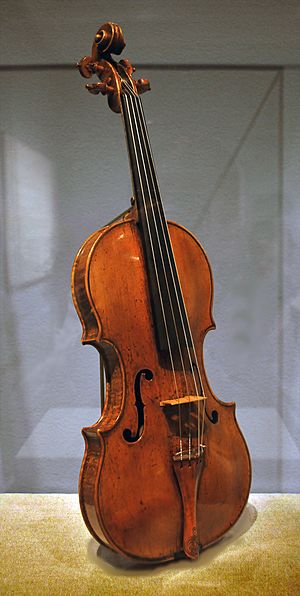Andrea Amati facts for kids
Quick facts for kids
Andrea Amati
|
|
|---|---|
| Born | 1505 |
| Died | 26 December 1577 |
| Nationality | Italian |
| Occupation | luthier |
| Known for | Credited with constructing the first musical instrument of the modern violin family |

Andrea Amati was a skilled luthier from Cremona, Italy. A luthier is someone who makes or repairs stringed instruments like violins.
Amati is famous for creating the very first instruments of the violin family that look and sound like the ones we use today. Many of the instruments he made hundreds of years ago still exist. Some of them can even be played!
A large number of his surviving instruments were part of a special order. He made 38 instruments for Charles IX of France in 1564.
Amati and the French King
Andrea Amati made about 38 instruments for the French royal family. This order was placed between 1560 and 1574. It was for Catherine de Medici, who was the Queen Regent of France. She was acting on behalf of her young son, Charles IX of France.
One very special instrument was a gilded bass violin. It was beautifully painted with royal symbols. This instrument was called The King. It was made for Charles IX.
The exact date The King was made is a bit uncertain. Its label says 1572, but some experts think it might have been made earlier.
Sadly, many of these royal instruments were destroyed. This happened during the French Revolution much later. But some pieces were saved by a student named M. J. B. Cartier. Today, The King violin is part of the collection at the National Music Museum. You can find it in Vermillion, South Dakota.
How the Modern Violin Began
The violin's history goes back to around 1520. We know this from old pictures and writings. Experts don't fully agree on how the early violin developed.
Before Amati, there were instruments like the rebec and the fiddle. There was also the violoncello, which is like a cello. These instruments can be seen in old Italian paintings.
However, a famous auction house, Sotheby's, says something important. They believe there was no clear example for the amazing instruments Amati created. He made these for Charles IX of France and Pope Pius V starting around 1566.
Amati might have added a fourth string to an older instrument. This older instrument was louder and played outdoors for dancing. But Amati's real genius was changing everything. He made the violin a beautiful instrument fit for a royal court. Before him, it was mostly used by common people.
Many scholars believe Andrea Amati was the inventor of the violin. Two other people are also considered. One was Fussen, from a region now in Germany. The other was Gasparo' da Salo from Brescia, Italy.
When Amati started making instruments, violins usually had only three strings. Andrea Amati is given credit for creating the first violin-like instrument with four strings.
Amati's first violins were a bit smaller than today's violins. They had high arches and wide purfling. Purfling is the decorative border around the edge of a violin. They also had elegant curves in their scrolls and bodies.
Andrea Amati's family continued his amazing work. His two sons, Antonio Amati and Girolamo Amati, became skilled violin makers too. His grandson, Nicola Amati, was also a master. Nicolò Amati taught many famous apprentices. These included Antonio Stradivari and Andrea Guarneri. These names are now legendary in the world of violins.

